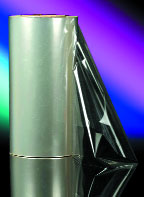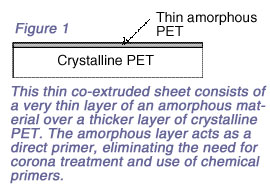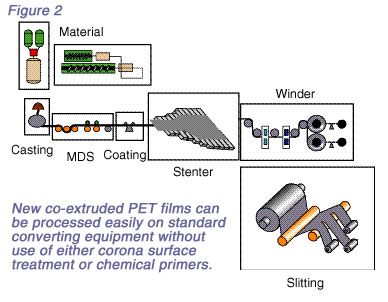Film Opens New Markets
- Published: February 28, 2005, By Steve Sargeant, PhD., Toray Plastics (America)
PET Film
Since pressure-sensitive labels and tapes—and other materials such as stamps—have become more sophisticated, the market for these materials has been expanding rapidly. In such product constructions, it has been common practice to apply a release coating, typically a silicone-based material, to the paper liner from which the materials are peeled or dispensed.
These relatively low-end applications require neither sophisticated equipment nor chemical priming to provide the necessary adhesion performance requirements for the release coatings. However, as converters seek to upgrade to higher-end release applications, many of which require high-strength films in place of paper liners, adhesion performance requirements for the release coatings have become far more stringent.
With low-end applications such as mailing labels, for example, precise control of peel strength is relatively unimportant since they normally are removed by hand or relatively slow equipment, and speed of release is not a prime consideration. Adhesion of the silicone to the liner also is not a primary consideration, since small amounts of silicone transferred by the adhesive to the surface to which the tapes and labels are affixed do not affect performance significantly. However, in the case of high-end optical, electrical, and medical release applications, factors such as peel strength, release speed, and silicone adhesion become absolutely critical.
Some common examples of these higher-end applications include films used to label and create brand awareness or to protect optical glass from damage during shipment or installation; tapes used to mask optical or electrical circuits; adhesive backings for commercial signage, and release liners for medical tapes and bandages that are applied to human skin.

Other examples include labels intended for permanent or semi-permanent attachment to relatively expensive parts and components, such as foil or hot-stamped labels imprinted with consecutive serial numbers. In cases such as these, silicone adhesion is especially important, since even small quantities of silicone transferred to the surface on which the tape, label, or film is affixed can interfere with optical or electrical transmissions. It also can affect the bond strength of permanent and semi-permanent labels and, in the case of human skin contact with medical devices, health concerns might be an issue.
Still another application requiring firm adhesion with controlled release is film packaging for chocolate and other heat-sensitive confectionary products, which cannot be easily heat-sealed or closed with conventional hot melt adhesives without causing the packaged product to melt. Confectionary marketers increasingly are switching from specialty papers to plastic films for such applications and are relying on FDA-approved controlled release adhesives to seal them.
In order to meet these more demanding silicone bonding and release requirements, converters need to upgrade their silicone coating equipment significantly to add capabilities such as corona surface treatment and the application of chemical primers. Unfortunately, such upgrades not only increase overall production costs but also can severely limit the speed at which the production line can be run. Today, however, new coextruded PET film technology can eliminate the need for either priming or corona treatment and provide superior silicone adhesion properties as well, allowing converters not only to achieve higher production speeds but to divert equipment previously used for silicone coating to more profitable applications.
Today’s new coextruded PET films are made with a thin coextruded sheet consisting of a very thin layer of an amorphous material over a thicker layer of crystalline PET. The amorphous layer acts as a direct primer, eliminating the need for corona treatment and/or the use of chemical primers that require hazardous solvents. Also, since the amorphous layer is tightly bonded to the crystalline PET core layer, it increases the anchorage of the silicone coating, preventing unwanted migration to other surfaces. One version of the new coextruded PET film is shown in Figure 1.

The new coextruded films exhibit excellent physical properties that allow them to be laminated, printed, or vacuum metallized easily. These properties are shown in Table I.
| Table I | ||||
| Basic Properties of New Co-Extruded Films | ||||
|---|---|---|---|---|
| Film | ||||
| Tensile Strength | kg/mm2 | MD | 31 | |
| TD | 27 | |||
| Elongation at Break | % | MD | 114 | |
| 126 | ||||
| Heat | 150ºC 30 min. | % | MD | 2.1 |
| Shrinkage | TD | 0.8 | ||
| 190ºC 5 min. | % | MD | 4.9 | |
| TD | 3.6 | |||
| Friction | μs | 0.4 | ||
| (Treated/Non-treated) | μd | 0.4 | ||
| Haze | 3.3 | |||
| Internal Haze | 1.9 | |||
| Gloss | MD | 143 | ||
| TD | 140 | |||
| TLT | % | 96 | ||
| Surface Energy | Treated Side | dyne/cm | 48 | |
| Non-treated | 44 | |||
New coextruded PET sheets exhibit excellent physical properties that allow them to be laminated, printed, or vacuum metallized easily.
Corona Treatment and Chemical Primers Eliminated
The new coextruded technology enables films to be processed easily on standard converting equipment without use of either corona surface treatment or chemical primers. The film is prepared by coextrusion of the asymmetric materials and then stretched in the machine direction by feeding it through a series of low-speed rollers into a series operating at higher speeds.
The film is then grasped by the edges by clamps that diverge as they pass along the production line to stretch it in the transverse direction.
Finally, it can be wound onto rolls that then can be slit into appropriate lengths and widths. This process is shown in Figure 2.

This simple production process, by eliminating corona treatment and chemical primers, offers converters several significant advantages. For example, with corona treatment, it can be difficult to control back-side treatment through unintended or unwanted air gaps on plastic substrates as they pass over the treater rolls. Furthermore, it is difficult to maintain a consistent treatment level across a moving web with corona treatment. By eliminating the need for this processing step, the new coextruded films not only allow the converter to increase the speed of the processing line significantly but also to provide much greater flexibility in terms of subsequent processing.
Similarly, eliminating the need for in-line chemical priming offers several significant advantages. One obvious advantage is the elimination of volatile organic compounds (VOCs) generated by the solvents used for priming. This, in turn, eliminates not only the need for special venting equipment required to meet EPA regulations but also the danger of explosion that could be caused by a spark from the previously required corona treatment. In addition, by eliminating the need for a special coating pass or use of a two-stage coating station, the converter is able to generate additional business by utilizing the equipment for more profitable coating applications.
Finally, if the new coextruded PET films are fully FDA- compliant, they allow the converter to pursue new markets and applications, such as medical products, that offer the potential for a higher return on investment than previously available.
Higher Performance Standards
In addition to reduced costs and opportunities for increased profits, the new coextruded PET film technology also allows converters to offer customers higher standards of performance. One well-known manufacturer of silicone release coatings, for example, documented this by applying the same formulation to four different PET films as follows:
- Film A, an untreated and unprimed smooth surface PET film;
- Film B, an untreated and unprimed rough-surface PET film;
- Film C, an in-line-treated and primed PET film; and
- Film D, an untreated and unprimed new coextruded PET film.
After curing by a platinum (Pt) catalyst at a concentration of 120 ppm, each coated film was tested for ruboff and cure stability. The results of these tests are shown in Table II.
| Tabel II | ||||
| Silicone Adhesion Data—Pt Cured | ||||
|---|---|---|---|---|
| Material | Adhesion Promoting Layer | Cure Inhibition | Rub Off | Cure Stability |
| Film A | None | No | Yes | Moderate |
| Film B | None | No | Yes | Moderate |
| Film C | Coated | Yes | No | Excellent |
| Film D | Co-extrusion | No | No | Excellent |
The results of these tests, conducted by a well-known manufacturer of silicone release coatings, clearly demonstrate the superiority of the new coextruded PET films over both untreated/unprimed and in-line treated and primed PET films.
In these tests, neither Film A nor Film B had an adhesion-promoting layer, and the silicone release coating was applied directly to the untreated, unprimed film. As can be seen from the test results, it was very susceptible to ruboff and exhibited only moderate cure stability.
Film C, on the other hand, had an adhesion-promoting layer applied by in-line treatment. While it was not susceptible to ruboff and exhibited excellent cure stability, the adhesion-promoting layer inhibited its cure, probably by poisoning the Pt catalyst.
Film D, however, the new coextruded film with its amorphous PET layer acting as a direct primer, had no tendency to inhibit curing, yet still exhibited excellent cure stability and resistance to ruboff.
In order to determine the seven-day storage stability of the new coextruded PET film coated with a silicone release layer, it was stored at 40 deg C and 80% relative humidity, then tested for ruboff and retention of release and adhesion. The test results, shown in Table III, demonstrate its ability to maintain its desirable properties over time.
| Tabel III | |||
| Silicone Adhesion Storage Stability co-extrusion PET surface film | |||
|---|---|---|---|
| Release Values | |||
| Days | Temperature | 300º/Minute | 1200º/Minute |
| 1 | 40 | 44 gram | 37 gram |
| 3 | 40 | 40 gram | 39 gram |
| 7 | 40 | 48 gram | 50 gram |
The new coextruded PET film coated with a silicone release layer exhibits excellent seven-day storage stability at 40 deg C and 80% relative humidity.
The new coextruded PET films represent a significant technological advance over in-line treated and primed PET films. They offer significant cost savings and improved profitability by greatly simplifying the process by which a silicone release layer is applied as outlined in this article. They also represent an opportunity for converters to pursue new, higher-margin markets such as medical devices by offering FDA-approved materials with improved performance characteristics.
SUPPLIER INFO:
Toray Plastics (America)—toraytpa.com
Steve Sargeant, PhD., is director, new business development, Toray Plastics (America). Reach him at This email address is being protected from spambots. You need JavaScript enabled to view it. or 401/294-4511, ext. 4442. Toray Plastics’ new co-extruded PET for enhanced silicone adhesion is PS10.
The views and opinions expressed in Technical Reports are those of the author(s), not those of the editors of PFFC. Please address comments to author(s).





